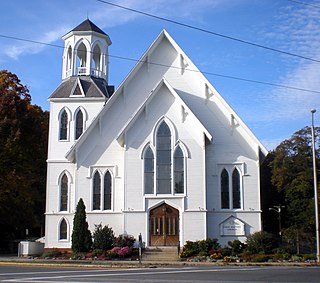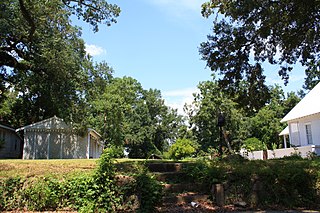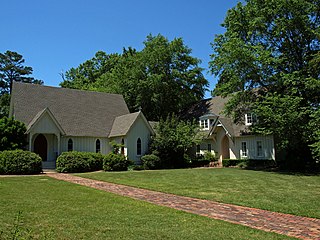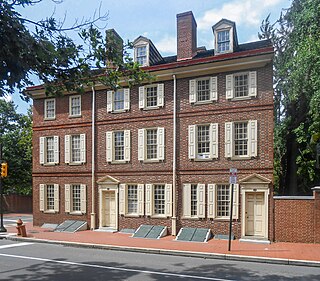
Carpenter Gothic, also sometimes called Carpenter's Gothic or Rural Gothic, is a North American architectural style-designation for an application of Gothic Revival architectural detailing and picturesque massing applied to wooden structures built by house-carpenters. The abundance of North American timber and the carpenter-built vernacular architectures based upon it made a picturesque improvisation upon Gothic a natural evolution. Carpenter Gothic improvises upon features that were carved in stone in authentic Gothic architecture, whether original or in more scholarly revival styles; however, in the absence of the restraining influence of genuine Gothic structures, the style was freed to improvise and emphasize charm and quaintness rather than fidelity to received models. The genre received its impetus from the publication by Alexander Jackson Davis of Rural Residences and from detailed plans and elevations in publications by Andrew Jackson Downing.

St. Andrew's Episcopal Church, also known as St. Andrew's Church is a historic church building on County Highway 12 in Prairieville, Alabama. Built by slaves in 1853, it is a remarkably well-preserved example of Carpenter Gothic architecture, its design apparently taken from a book by Richard Upjohn. St. Andrew's was added to the National Register of Historic Places on November 7, 1973, and was declared a National Historic Landmark on the same day. Public access is allowed to this National Historic Landmark.

Waldwic, also known as the William M. Spencer, III, House, is a historic Carpenter Gothic plantation house and historic district located on the west side of Alabama Highway 69, south of Gallion, Alabama. Built as the main residence and headquarters of a forced-labor farm worked by enslaved people, Waldwic is included in the Plantation Houses of the Alabama Canebrake and Their Associated Outbuildings Multiple Property Submission. The main house and plantation outbuildings were added to the National Register of Historic Places on July 22, 1994.

Ashe Cottage, also known as the Ely House, is a historic Carpenter Gothic house in Demopolis, Alabama. It was built in 1832 and expanded and remodeled in the Gothic Revival style in 1858 by William Cincinnatus Ashe, a physician from North Carolina. The cottage is a 1+1⁄2-story wood-frame building, the front elevation features two semi-octagonal gabled front bays with a one-story porch inset between them. The gables and porch are trimmed with bargeboards in a design taken from Samuel Sloan's plan for "An Old English Cottage" in his 1852 publication, The Model Architect. The house is one of only about twenty remaining residential examples of Gothic Revival architecture remaining in the state. Other historic Gothic Revival residences in the area include Waldwic in Gallion and Fairhope Plantation in Uniontown. Ashe Cottage was added to the Alabama Register of Landmarks and Heritage on August 22, 1975, and to the National Register of Historic Places on 19 October 1978.

First Baptist Church is an historic Baptist church building at 30 Park Street in Methuen, Massachusetts. Built in 1869 for a congregation established in 1815, it is one of the town's finest examples of Carpenter Gothic architecture. It was listed on the National Register of Historic Places in 1984.

The Belchertown Center Historic District is a historic district which encompasses the historic village center of Belchertown, Massachusetts. Centered on Belchertown's 1,200-foot (370 m) common, the district includes 55 contributing properties along South Main Street, Maple Street, and a few adjacent streets. It was listed on the National Register of Historic Places in 1982.

Fairhope Plantation is a historic Carpenter Gothic plantation house and historic district, located one mile east of Uniontown, Alabama, US. The 2+1⁄2-story wood-framed main house was built in the Gothic Revival style in the late 1850s. The plantation historic district includes six other contributing buildings, in addition to the main house. It was added to the Alabama Register of Landmarks and Heritage on December 19, 1991, and subsequently to the National Register of Historic Places on May 29, 1992, due to its architectural and historical significance.

The Tschiener House, also known as the Dumas School, was a historic residence in Mobile, Alabama, United States. The Carpenter Gothic structure was built in 1866. It was placed on the National Register of Historic Places on January 18, 1982. It was later destroyed by fire. One former outbuilding remains at the site.

Grace Episcopal Church is a historic Episcopal church in Mount Meigs, Alabama. The Carpenter Gothic structure was built in 1892. The building was placed on the Alabama Register of Landmarks and Heritage on January 29, 1980, and the National Register of Historic Places on February 19, 1982.

The Dolley Todd House or Dolley Todd Madison House in Philadelphia, Pennsylvania is a house constructed by carpenter John Dilworth 1775. The house was the residence of Dolley Madison, who lived in the home with her first husband John Todd Jr. prior to his death in 1793. It is located at 341 Walnut Street in the Society Hill neighborhood of the city.

The George M. Brown House is a historic residence in Provo, Utah, United States, that is listed on the National Register of Historic Places. It was built as a home for a "polygamous wife" of lawyer George M. Brown. It is listed on the National Register of Historic Places.
This is a list of the 26 multiple property submissions on the National Register of Historic Places in Alabama. They contain more than 288 individual listings of the more than 1,200 on the National Register in the state.

Christian Church and Parsonage is a historic church and parsonage in Plantersville, Alabama. Both the church and the parsonage were built in 1898. The pair were added to the National Register of Historic Places in 1987.

The Dr. James Alvis Beavers House is a historic house in Cuba, Sumter County, Alabama. The one-and-a-half-story wood-frame house was built by Stephen M. Potts between 1854 and 1857. Initially built in a simpler style, the house was modified in succeeding decades into a picturesque combination of the Greek Revival and Gothic Revival styles. It was purchased by Dr. James Alvis Beavers in 1898. The Beavers family retained ownership until 1980, when it was acquired at auction by the Charles Munoz family. It was added to the National Register of Historic Places on August 31, 2000.

The Antique Store is a historic commercial building in Plantersville, Dallas County, Alabama. It is the oldest surviving commercial building in the community. The one-story, wood-frame structure was built in 1870. The main facade is three bays wide, with a pedimented one-story porch spanning the entire width. A side ell, added after the initial construction, projects from the south side of the main block. It was added to the National Register of Historic Places on January 29, 1987, as a part of the Plantersville Multiple Resource Area.
The Doctor's Office was a historic professional office building in Plantersville, Dallas County, Alabama. The one-story, wood-frame structure was built in a vernacular interpretation of Greek Revival architecture c. 1850. The narrow main facade was three bays wide, with a pedimented one-story porch spanning the entire width. An entrance was situated in the middle bay, with a window to either side. The interior contained a single room. It was added to the National Register of Historic Places on January 29, 1987, as a part of the Plantersville Multiple Resource Area.

The Driskell–Martin House is a historic house in Plantersville, Dallas County, Alabama. It is the oldest surviving high style residence in the community. The two-story wood-frame house was built for Thomas Sanford Driskell, a planter and a merchant from Virginia, in 1850. The builders were Nelson Mitchell and Massena Godwin. The house was used as a Union headquarters during the American Civil War. Their forces occupied it during Wilson's Raid through Alabama in April 1865. The house remained in the Driskell family until purchased by Dr. Thomas Munroe Martin in 1915.

The Buell–Stallings–Stewart House is a historic residence in Greenville, Alabama. The house was built in 1874 by a local lawyer David Buell, who later sold it to U. S. Congressman Jesse F. Stallings. Stallings sold the house to A. Graham Stewart, a local merchant, in 1901. The house is built in a Carpenter Gothic style, rare in Alabama, and features a steeply sloped roof and several sharply pointed gables and dormers. A flat-roofed, octagonal porch projects over the front entry. Each window and door is topped with a decorative Gothic arch molding with a diamond in the middle. The house was listed on the National Register of Historic Places in 1986.

The Gurley Historic District is a historic district in Gurley, Alabama. The town was originally the plantation of John Gurley, who came to Madison County from North Carolina in the 1830s. In 1857, the Memphis and Charleston Railroad built its line through the property, and Gurley constructed a water tank to service the line's locomotives. A post office was established in 1866, at which time only a few families lived in the area. The town incorporated in 1890, and the population immediately began to grow. Industry was attracted to the area by its abundance of lumber; many sawmills, producers of wooden barrels, and the Eagle Pencil Company set up shop near the town. Retail establishments were centered on Joplin Street, however a fire in 1923 destroyed most of the structures. Depletion of the area's timber and the greater influence of neighboring Huntsville drew industry away in the 1920s and 1930s, though despite declining population a new Madison County High School was built in 1936.

The Boonton Historic District is a 9-acre (3.6 ha) historic district along Main, Church, Birch, Cornelia, and Cedar Streets in the town of Boonton in Morris County, New Jersey. It was added to the National Register of Historic Places on September 29, 1980, for its significance in architecture. The district has 22 contributing buildings, including the Boonton Public Library, which was previously listed individually on the NRHP.




















